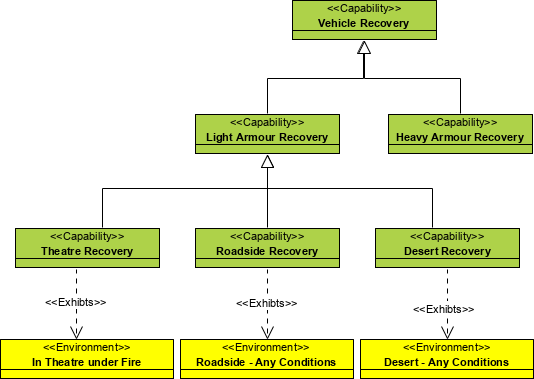The CV-2 presents capabilities and the hierarchical relationships between them. CV-2 specifies all the capabilities that are referenced throughout one or more architectures – i.e. one CV-2 may provide the definitive list of capabilities for a number of logical and physical architectures. In addition, it can be used as a source document for the development of high-level use cases and user requirements.
Usage
The intended usage of the CV-2 includes:
- Identification of capability requirements.
- Capability planning (capability taxonomy).
- Codifying required capability elements.
- Capability audit.
- Capability gap analysis.
- Source for the derivation of cohesive sets of user requirements.
- Providing reference capabilities for architectures.
Product Description
The CV-2 specifies a hierarchy of capabilities. When capabilities are referenced in operational or systems architectures, it may be that a particular facility, location, or organization or configuration meets more than one level of capability. The CV-2 is used to capture and organize the capability functions – required for the vision set out in the CV-1 Vision.
In CV-2, the Capabilities are only described in the abstract – i.e., CV-2 does not specify how a capability is to be implemented. A CV-2 is structured as a hierarchy of capabilities, with the most general at the root and most specific at the leaves.
Creating a Capability Taxonomy
To create a Capability Taxonomy diagram:
- Click on Capability Taxonomy in the Action Artifact area, and then select Create New Diagram.
- Type the diagram name and press Enter.
- A blank diagram is created and you can start constructing the view. You can create Capabilities and connect them through the tools under the diagram toolbar.

DoDAF in Visual Paradigm
The DoDAF is brought to you by Visual Paradigm, a full-featured development platform. Visual Paradigm provides an easy-to-use, model-driven DoDAF tool that supports the development of DoDAF 2.02 views and models. You can create integrated DoDAF products and generate architectural documents that facilitate organizations to efficiently coordinate enterprise architecture initiatives.